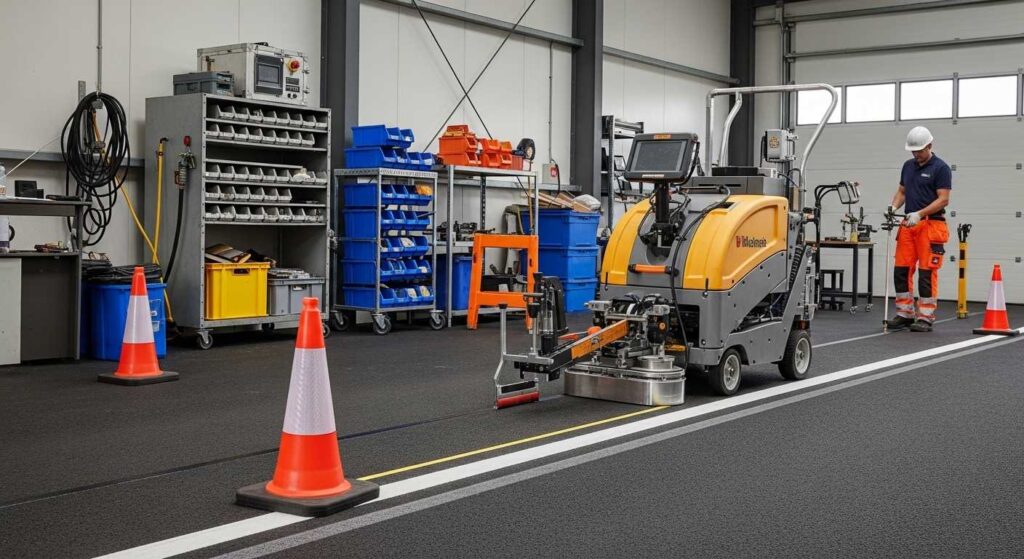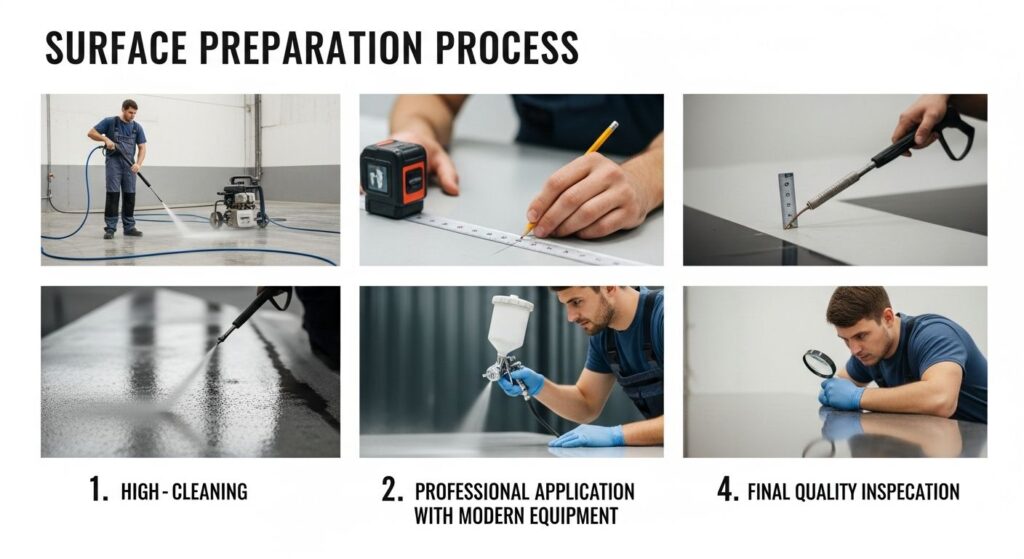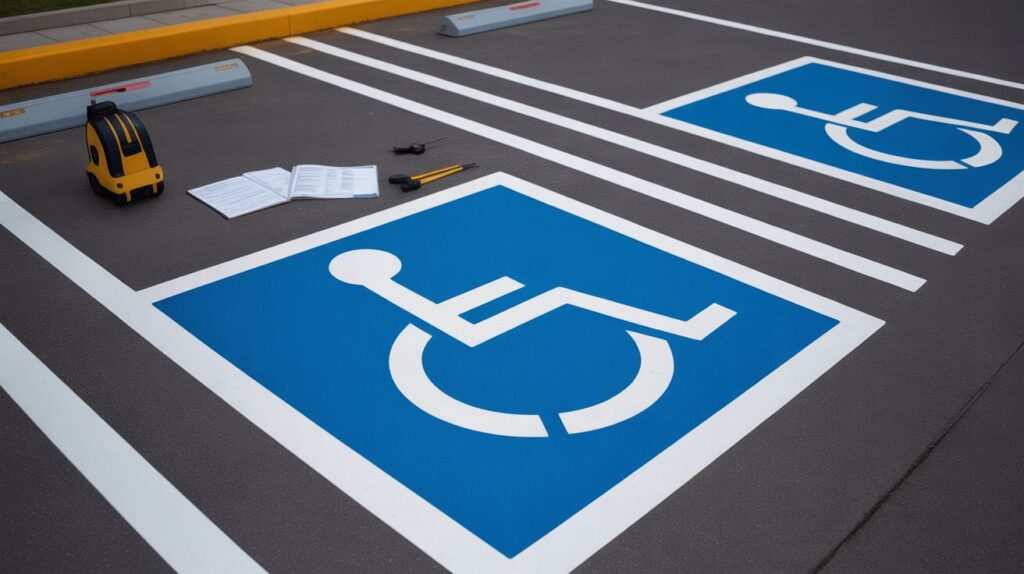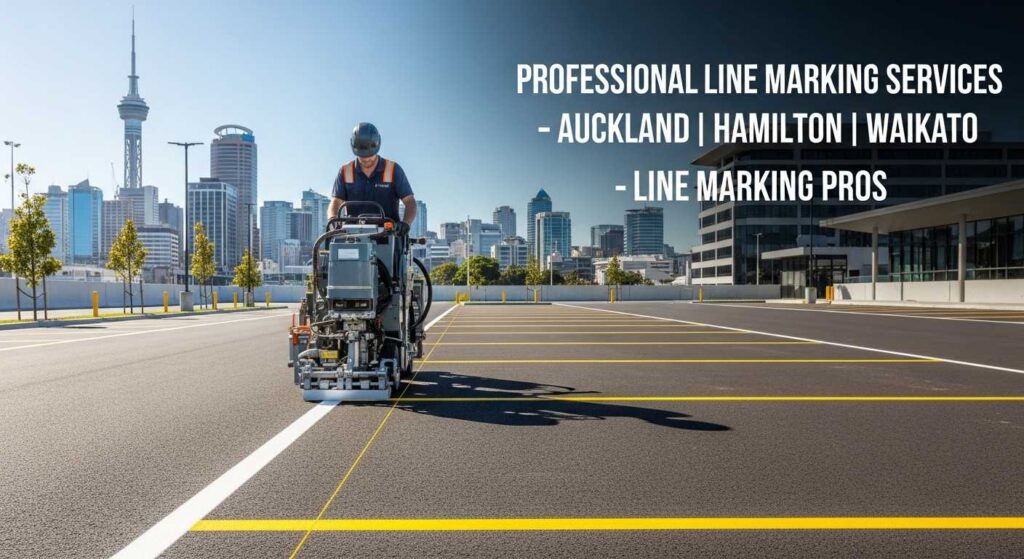Line marking is the foundation of modern traffic management, safety compliance, and organized facility operations across New Zealand.
Whether you’re managing a bustling car park in Auckland, overseeing warehouse operations in Hamilton, or maintaining school safety zones in Tauranga, professional line marking serves as the silent guardian that keeps people, vehicles, and operations moving safely and efficiently.
At Line Marking Pros, we’ve spent over five years perfecting the art and science of professional line marking across the upper North Island.
From precision road markings that meet stringent NZ standards to comprehensive industrial line marking solutions, our expertise helps transform spaces into safer, more organized environments that exceed compliance requirements while supporting operational excellence.
Understanding Line Marking: More Than Paint on Pavement

Line marking encompasses the systematic application of visual guidance systems—primarily lines, symbols, and markings—to surfaces such as roads, car parks, warehouses, schools, and industrial facilities. These markings serve multiple critical functions: traffic flow management, safety zone designation, compliance with regulatory standards, and operational efficiency enhancement.
Modern professional line marking extends far beyond simple paint application. It involves careful surface preparation, material selection, precision application techniques, and adherence to strict safety and compliance standards in linemarking. The process requires specialized equipment, technical expertise, and deep understanding of local regulations—particularly New Zealand’s comprehensive safety and accessibility standards.
The Critical Role of Professional Line Marking Services
Safety and Compliance Foundation
Professional line marking forms the backbone of workplace safety and public protection. In New Zealand, facilities must comply with various standards, including NZS 4121:2001 for accessibility requirements, particularly for disabled parking spaces and accessible routes. These compliance requirements aren’t merely suggestions—they’re legal obligations that protect both facility users and property owners from liability issues.
Safety compliance line marking extends beyond basic traffic management. In industrial settings, properly marked safety zones, walkways, and hazard areas can prevent serious accidents, reduce insurance costs, and ensure WorkSafe New Zealand compliance. The visual clarity provided by professional markings helps workers and visitors immediately understand safe zones, traffic patterns, and potential hazard areas.
Operational Efficiency and Organization
Well-designed line marking systems dramatically improve operational efficiency. In warehouse environments, clearly marked traffic lanes, storage areas, and loading zones reduce congestion, minimize equipment damage, and optimize workflow patterns. Car park line marking maximizes space utilization while ensuring smooth traffic flow and reduced parking disputes.
The precision of professional line marking also reduces maintenance requirements. High-quality materials and expert application techniques ensure markings remain visible and effective for years, reducing the need for frequent touch-ups or complete remarking projects.
Types of Line Marking Applications

Road Line Marking
Road marking represents the most visible and critical application of professional line marking services. These markings include centerlines, edge lines, turning arrows, pedestrian crossings, and specialized symbols that guide traffic flow and enhance road safety in road marking solutions. Road line marking must withstand extreme weather conditions, heavy traffic loads, and maintain visibility in all lighting conditions.
Professional road marking contractors use advanced materials like thermoplastic compounds and specialized paints designed for durability and retroreflectivity. The application process requires precise measurement, traffic management, and adherence to New Zealand Transport Agency (NZTA) specifications.
Car Park Line Marking
Car park marking presents unique challenges requiring both technical precision and strategic planning. Effective line marking for car park applications must optimize space utilization while ensuring safe vehicle and pedestrian movement. This includes standard parking bay markings, directional arrows, loading zone designations, and accessibility compliance markings.
Modern line marking car park projects incorporate various elements: 90-degree parking bays, angled parking configurations, compact car spaces, motorcycle parking, and specialized areas for electric vehicle charging stations. Each element requires specific dimensions and clearances as outlined in relevant New Zealand standards.
Industrial and Warehouse Line Marking
Industrial line marking serves critical safety and operational functions in manufacturing, warehousing, and distribution facilities. These applications include traffic lane markings for forklifts and pedestrians, safety zone boundaries, equipment placement markers, and emergency evacuation route markings.
Warehouse line marking typically employs color-coded systems where yellow indicates caution areas and traffic lanes, white marks general areas and storage zones, red designates fire safety equipment and emergency areas, and black and yellow diagonal stripes mark permanent hazard zones. This standardized approach ensures immediate recognition of different zones and safety requirements.
School and Sports Court Line Marking
Educational facilities require specialized line marking solutions that combine safety, functionality, and durability. School line marking includes playground boundaries, sports court markings, parking areas, bus zones, and pedestrian safety areas. These markings must withstand constant use by children while maintaining clear visibility for supervision and safety management.
Sports court line marking demands exceptional precision, as even minor variations can affect gameplay and competition standards. Professional contractors use laser-guided equipment to ensure accurate measurements and consistent line widths that meet official sporting regulations and health and safety requirements.
Professional Line Marking Materials and Technology

Advanced Material Options
Modern line marking utilizes various specialized materials, each selected for specific performance characteristics and application requirements. Water-based acrylic paints offer environmental friendliness and quick drying times, making them ideal for projects requiring minimal disruption. These materials work well for indoor applications and areas with moderate traffic loads.
Thermoplastic compounds represent the premium choice for high-traffic areas requiring maximum durability. These materials are heated and applied as molten compounds that bond molecularly with the pavement surface, crucial for effective road marking solutions. Thermoplastic markings typically last 3-5 times longer than conventional paint, making them cost-effective for busy car parks and roads despite higher initial costs.
Specialized epoxy systems provide exceptional chemical resistance and durability for industrial applications. These materials withstand exposure to oils, solvents, and heavy equipment loads common in warehouse and manufacturing environments.
Precision Application Equipment
Professional line marking relies on sophisticated equipment designed for accuracy, efficiency, and consistent results. Modern line marking machines include computer-controlled systems that ensure precise line widths, consistent material application rates, and accurate positioning. Laser-guided technology eliminates human error in measurement and alignment, producing professional results that meet strict compliance standards.
Airless spray systems provide superior material atomization and application control, resulting in smooth, even coverage with minimal overspray. These systems accommodate various materials from thin paints to thick thermoplastic compounds, offering versatility for different project requirements.
Surface preparation equipment includes high-pressure cleaning systems, scarification machines for removing old markings, and shot-blasting equipment for optimal surface preparation. Proper surface preparation directly impacts marking adhesion and longevity, making these tools essential for professional results.
The Professional Line Marking Process

Comprehensive Site Assessment
Every professional line marking project begins with thorough site assessment and planning. This phase involves evaluating surface conditions, identifying potential challenges, measuring areas accurately, and developing detailed application plans. Site assessment also includes reviewing compliance requirements, traffic management needs, and scheduling considerations to minimize disruption.
Surface condition evaluation determines the preparation methods required and identifies any repairs needed before marking application. Factors considered include surface material, existing marking condition, oil stains or contamination, surface texture, and drainage characteristics.
Surface Preparation Excellence
Surface preparation significantly impacts marking quality and longevity. Professional contractors employ various preparation techniques depending on surface conditions and project requirements. High-pressure cleaning removes dirt, debris, and surface contaminants that could interfere with material adhesion.
Existing marking removal may require scarification, grinding, or chemical stripping to ensure clean surfaces for new applications. This step prevents ghosting effects where old markings show through new ones and ensures optimal adhesion of new materials in road marking NZ.
Surface repairs address cracks, holes, or deteriorated areas that could compromise marking integrity. Professional contractors coordinate with pavement repair specialists when necessary to ensure markings are applied to structurally sound surfaces.
Precision Application and Quality Control
The application phase combines technical expertise with advanced equipment to achieve professional results. Line marking contractors use computer-controlled equipment for consistent line widths, precise positioning, and uniform material application. Laser guidance systems ensure straight lines and accurate measurements, while spray pattern controls provide even coverage without streaking or thin spots.
Quality control measures include continuous monitoring of material consistency, application rates, and dimensional accuracy. Professional contractors verify measurements throughout the application process and conduct final inspections to ensure all markings meet specifications and compliance requirements.
Line Marking Compliance and Standards in New Zealand

NZS 4121:2001 Accessibility Requirements
New Zealand’s accessibility standard, NZS 4121:2001, establishes specific requirements for disabled parking spaces and accessible routes. These requirements include precise dimensions for parking spaces (minimum 3.5m wide by 5.0m long), access aisle specifications, proper signage placement, and surface requirements for carpark linemarking.
Compliance with accessibility standards protects property owners from discrimination complaints and ensures facilities serve all community members effectively. Professional line marking companies maintain current knowledge of these requirements and ensure all accessibility markings exceed minimum standards.
WorkSafe New Zealand Guidelines
Industrial and commercial facilities must comply with WorkSafe New Zealand guidelines for workplace safety, including proper marking of hazardous areas, emergency routes, and traffic management systems. These guidelines emphasize clear visual communication of safety information through standardized color codes and marking systems.
Professional safety compliance line marking incorporates these guidelines into comprehensive marking systems that protect workers, visitors, and equipment. Regular updates ensure marking systems remain current with evolving safety requirements and best practices.
Local Council Requirements
Regional councils throughout New Zealand maintain specific requirements for line marking in public areas, development projects, and commercial facilities. These requirements vary by location but typically address factors such as materials specifications, application techniques, and ongoing maintenance responsibilities.
Line marking contractors working across multiple regions, such as Auckland, Hamilton, Waikato, Tauranga, and Whangarei, maintain expertise in various local requirements to ensure compliance regardless of project location.
Choosing Professional Line Marking Contractors
Technical Expertise and Experience
Professional line marking requires specialized knowledge encompassing surface preparation, material science, application techniques, and compliance requirements. Experienced contractors understand how different materials perform under various conditions and can recommend optimal solutions for specific applications.
Look for line marking companies with proven track records in your specific application type. Industrial line marking requires different expertise than school playground marking, and road marking contractors need specialized traffic management capabilities to meet safety marking standards.
Advanced Equipment and Technology
Modern line marking demands sophisticated equipment for professional results. Contractors using laser-guided systems, computer-controlled application equipment, and comprehensive surface preparation tools typically deliver superior results with greater efficiency and accuracy.
Ask potential contractors about their equipment capabilities, maintenance programs, and technology investments. Companies investing in advanced equipment demonstrate commitment to quality and efficiency that benefits clients through better results and competitive pricing.
Comprehensive Service Offerings
Full-service line marking contractors provide value through comprehensive capabilities including surface assessment, preparation, application, and ongoing maintenance. This integrated approach ensures consistency throughout the project lifecycle and simplifies project management for clients.
Consider contractors offering additional services such as surface repairs, signage installation, and maintenance programs. These expanded capabilities often provide cost savings and improved project coordination compared to managing multiple specialized contractors.
Regional Line Marking Services Across the Upper North Island
Line Marking Auckland: Metropolitan Excellence
Auckland’s diverse facility types require specialized line marking expertise across commercial, industrial, educational, and public applications. The metropolitan area’s high traffic volumes and dense development patterns demand durable materials and precise application techniques that withstand heavy use while maintaining clear visibility.
Auckland line marking projects often involve complex scheduling to minimize disruption in busy commercial areas. Professional contractors coordinate with facility managers, traffic control authorities, and other stakeholders to ensure efficient project completion with minimal operational impact.
Line Marking Hamilton: Industrial and Commercial Focus
Hamilton’s strong industrial base creates demand for specialized warehouse line marking and manufacturing facility applications. These projects require expertise in safety compliance, material handling optimization, and integration with existing operational systems.
Hamilton line marking contractors must understand the unique requirements of agricultural processing, manufacturing, and distribution facilities that form the region’s economic foundation. This includes knowledge of specialized equipment clearances, loading dock configurations, and safety protocol integration for effective line marking needs.
Line Marking Waikato: Rural and Agricultural Applications
The broader Waikato region presents diverse line marking challenges spanning rural facilities, agricultural processing centers, and recreational areas. Line marking Waikato projects often involve unique applications such as livestock facility markings, rural school configurations, and seasonal facility modifications.
Understanding regional weather patterns, soil conditions, and agricultural cycles helps contractors optimize project timing and material selection for maximum durability and cost-effectiveness.
Line Marking Tauranga: Port and Logistics Specialization
Tauranga’s role as a major port city creates specialized demand for logistics facility line marking, container storage area markings, and heavy equipment traffic management systems. These applications require expertise in large-scale projects, specialized materials for harsh marine environments, and coordination with port authority requirements.
Line marking Tauranga contractors must understand the unique challenges of coastal environments, including salt exposure, high humidity, and intensive industrial use patterns that affect material selection and application techniques.
Line Marking Whangarei: Community and Industrial Balance
Whangarei’s mix of community facilities, educational institutions, and industrial operations requires versatile line marking capabilities spanning multiple application types. Contractors serving this region must demonstrate expertise across diverse project types while maintaining competitive pricing for smaller community projects.
The region’s growth patterns create opportunities for new facility development, requiring contractors capable of supporting both new construction and renovation projects with comprehensive line marking solutions.
Maintenance and Longevity of Professional Line Markings
Preventive Maintenance Programs
Professional line markings require ongoing maintenance to preserve visibility, compliance, and operational effectiveness. Preventive maintenance programs include regular inspections, cleaning procedures, and scheduled touch-up applications that extend marking life and maintain a professional appearance for all marking solutions NZ.
Maintenance schedules vary based on traffic patterns, weather exposure, and material types. High-traffic areas may require annual attention, while protected indoor markings might last several years between maintenance cycles, addressing specific line marking needs. Professional contractors develop customized maintenance programs based on specific facility needs and usage patterns.
Material Performance and Lifecycle Management
Different line marking materials offer varying performance characteristics and lifecycle costs. While thermoplastic materials cost more initially, their extended lifespan often provides better value for high-traffic applications. Conversely, water-based paints may offer better value for low-traffic areas or temporary applications.
Professional contractors help clients understand total lifecycle costs, including initial application, maintenance requirements, and eventual remarking needs. This analysis enables informed decisions that optimize both performance and budget considerations.
Seasonal Considerations for New Zealand Conditions
New Zealand’s varied climate conditions affect line marking performance and maintenance requirements. Winter weather patterns, summer heat, and regional variations in rainfall and UV exposure influence material selection and maintenance scheduling.
Professional contractors familiar with local conditions can recommend optimal timing for marking projects and maintenance activities. This regional expertise helps ensure markings perform effectively throughout New Zealand’s diverse weather patterns.
Future Trends in Line Marking Technology
Smart Marking Systems
Emerging technologies include smart marking systems incorporating reflective materials, LED integration, and sensor-activated guidance systems. These innovations enhance visibility in challenging conditions and provide dynamic traffic management capabilities for complex facilities.
Sustainable Materials and Practices
Environmental consciousness drives the development of sustainable line marking materials and application practices. Water-based formulations, recycled content materials, and energy-efficient application equipment reduce environmental impact while maintaining performance standards.
Digital Planning and Design Tools
Advanced software tools enable precise project planning, 3D visualization, and optimized layout design before material application. These tools reduce waste, improve accuracy, and help clients visualize proposed marking systems before implementation.
Conclusion: Excellence in Professional Line Marking
Professional line marking represents far more than simple paint application—it’s a comprehensive service combining technical expertise, advanced materials, precision equipment, and deep understanding of safety and compliance requirements. Whether you need road line marking for public safety, car park line marking for commercial efficiency, or industrial line marking for workplace safety, choosing experienced professionals ensures results that meet New Zealand’s demanding standards while providing long-term value.
The upper North Island’s diverse facility types and challenging conditions require contractors with proven expertise across multiple application types and regional variations. From Auckland’s metropolitan complexity to Waikato’s agricultural focus, professional line marking contractors must demonstrate technical competence, advanced equipment capabilities, and comprehensive understanding of local requirements.
At Line Marking Pros, we combine over five years of specialized experience with laser-guided precision technology and comprehensive compliance expertise to deliver exceptional results across Auckland, Hamilton, Waikato, Tauranga, Whangarei, and the broader upper North Island. Our commitment to safety-first practices, quality materials, and flexible scheduling ensures your line marking project exceeds expectations while supporting your operational goals.
Ready to transform your facility with professional line marking that exceeds New Zealand standards? Contact Line Marking Pros today for a comprehensive consultation and detailed quote. Our experienced team will assess your specific requirements, recommend optimal solutions, and deliver precision results that enhance safety, compliance, and operational efficiency.
Don’t compromise on quality—choose the upper North Island’s leading line marking specialists for your next project and ensure compliance with health and safety standards.
Call us now or request your free, no-obligation quote online. Let Line Marking Pros demonstrate why we’re New Zealand’s trusted choice for professional line marking solutions that stand the test of time.
FAQs
What Line Marking Solutions Do You Offer for Different Applications?
We provide line marking services across a comprehensive range of line marking solutions including road marking, carpark markings, walkway delineation, and warehouse floor markings. Our expert line marking services cover everything from commercial line marking to specialized floor markings with quality workmanship that ensures long-lasting results. Whether you need concrete grinding preparation or precise line marking using premium linemarking paint, our services tailored to your specific requirements deliver reliable and efficient outcomes cost effectively.
How Do Playground and Safety Marking Services Enhance Protection?
Playground markings and safety marking are essential for schools and playgrounds to ensure health and safety compliance. Our health and safety marking specialists create safety line marking solutions that improve traffic flow and provide clear guidance for pedestrians and vehicles. We work with educational facilities to install quality line marking that meets regulatory standards while creating engaging and safe environments for children and staff.
What Carpark and Road Marking Services Are Available in Auckland and Wellington?
Our linemarking services cover services in auckland, wellington, and the bay of plenty region. We specialize in auckland line marking projects and offer comprehensive road marking solutions throughout the auckland region. From disabled line marking to complete carpark layouts, our line marking experts deliver trusted line marking services with reliable service standards that exceed client expectations.
Why Choose Professional Linemarking Solutions for Health and Safety Compliance?
Professional linemarking solutions ensure your premises meet health and safety requirements while maintaining quality workmanship standards. Our expertise in road marking solutions extends to creating compliant warehouse floor layouts and pedestrian walkway systems. We understand local regulations and deliver line marking in nz that prioritizes safety without compromising on aesthetic appeal or functionality.
How Can I Contact You for Line Marking Services?
To get in touch with our team, simply contact us for a consultation about your linemarking needs. Our marking companies near you provide prompt responses and detailed quotes for all types of line marking projects. Whether you’re in Auckland, Wellington, or Bay of Plenty, our local expertise ensures you receive the most suitable linemarking solutions for your specific requirements.



